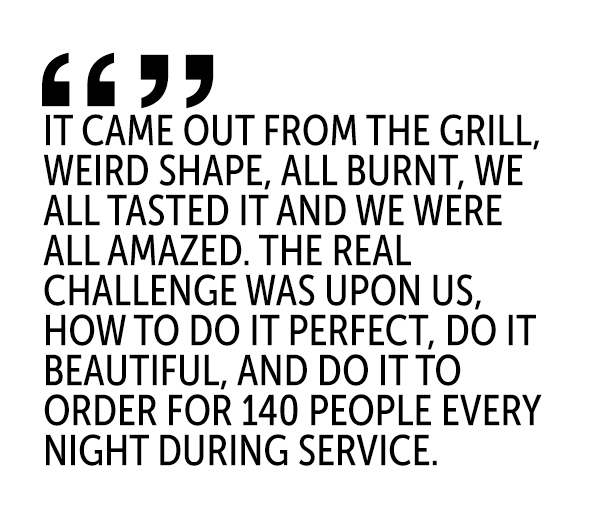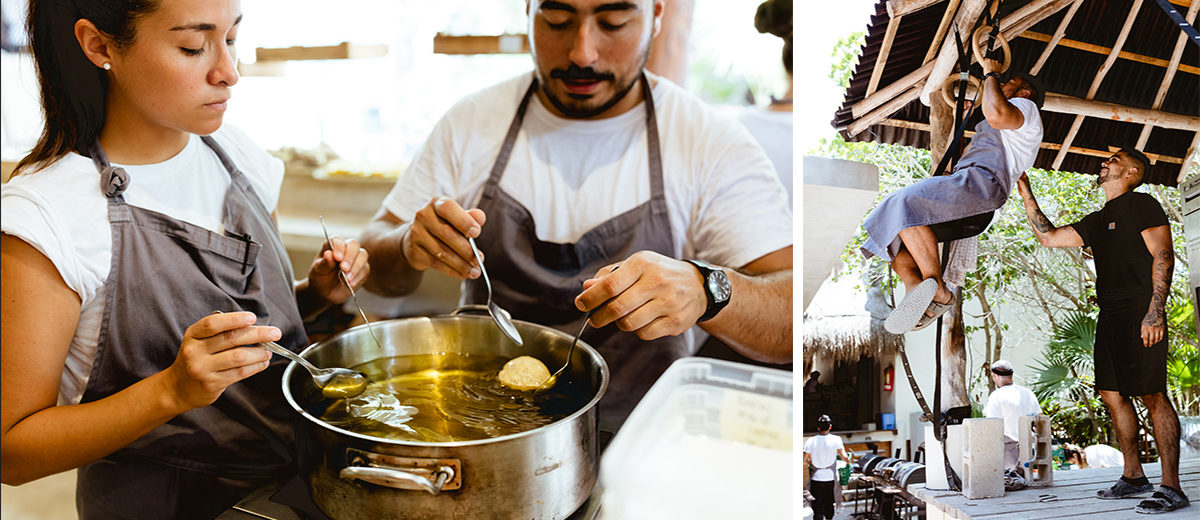On November 2016, René Redzepi dropped the news that Tulum in Mexico’s Quintana Roo would be the location for his third ever Noma pop-up. The $600 tickets sold out in a matter of three hours when they went on sale.
We were lucky to score a ticket and experience the unique immersive pop-up not just from a diner’s perspective, but also behind the scenes where the REAL magic happens – in the kitchen.
We are beyond thrilled to take you behind the scenes in our “Tales from Tulum” series, as we interview a few of the Noma Chefs and team members that made Noma Tulum happen.
Mexico native Pablo Soto has worked in some of the most acclaimed kitchens in the world including Enrique Olvera’s Pujol in Mexico City, Roberto Solís’ Nectar in Mérida, René Redzepi’s Noma in Denmark, Curtis Duffy’s Grace in Chicago, and Joël Robuchon’s in Monaco.
Along with Jose Luis Hinostroza, Pablo was also part of the Noma Mexico R&D team. The team consisted of a few chefs responsible for coming up with the unforgettable dishes of the pop-up like the Just cooked octopus with “dzikilpak” course wrapped and cooked in masa and served with “dzikilpak” – a traditional Yucatan region salsa made with habanero, tomato, and pepitas.
We had the chance to talk to Pablo about how he was chosen for the Noma Mexico R&D team, the impact Noma Mexico took on the local economy, and his take on “culinary colonialism“.
It’s the dream of most young chefs to even spend time working in a restaurant of Noma’s caliber. How did that first happen for you?
Back in 2012, I was Head Chef for Roberto Solis’ (who was also the first Mexican intern at Noma) restaurant Nectar in the Yucatan Peninsula, I had just come back from spending time in a Joël Robuchon two Michelin star restaurant in Monaco, and was super thirsty for more intensity. Noma was always a goal for me and I submitted my application almost a year in advance. You know how it works, sending an email and praying for them to say yes – they did. I ended up spending most of my time there interning at the test kitchen.
Were you chosen for the project because you were a Mexican chef? What do you think was expected from you to bring to the table?
Being Mexican was very important I think, but mostly, I really wanted to be there. I was willing to jump in fearlessly, get my hands dirty, and give my most sincere Mexican opinion and approach to any task I was given. It’s hard to know what they were expecting from me, but it is easy to say that the world was expecting amazingness from Noma Mexico and I wanted to put my work into it.
What was the situation like when you first showed up in Tulum? How close to the ground level of the project were you?
When I came in, all the research trips where done, construction was in early stages and we were starting to run a test kitchen in a beach front house. Before the opening day of the pop-up we had a full month of nonstop cooking trials with the most insane ingredients and all possible outcomes you could get with every one of them. So, I would say, very close to the ground experience since we were a very small team at first, and the work done in that first month was important for the outcome of the whole pop-up.
How was the menu designed? I understand that many dishes were built around a single local ingredient.
Imagine having ingredients delivered from all over Mexico’s territory, and I mean hundreds of different ones. You first start building some kind of palate with oils, reductions, ferments, powders, juices, etc., that can then be used or paired with other ingredients. Sauces, pickles, and grilled ingredients were coming out of that kitchen constantly for testing, and the cool stuff got written down and set for new trials, or maybe just discarded because it wasn’t delicious enough.
Part of what elevated the food so much in some ways, was the radical fusion of ancient local Mexican ingredients with modern and European styles and techniques of cooking. That’s also been the source of some criticism, with one writer saying the menu was no more Mexican than Taco Bell, just on a much higher end. Was there any resistance from the Mexicans involved with the project? Did anyone fight to keep some sort of purity?
There was never an intention of re-writing Mexican culinary traditions, which are already clearly documented and respected by everyone. As a team, we were all working hard with the great objective of making delicious food with all this already amazing produce; respect for tradition was something we were very careful about.

What impact did the project have on the local economy?
Well think of 700 people a week, staying at hotels, Instagramming about other great restaurants around, sharing their experience in paradise, the economic reach of this was huge for the whole country. Not to mention the people growing and foraging ingredients for our kitchen. These small local farmers and fisherman had their work showcased on a menu that was exposed to the world, and now chefs want their products because now they exist in the map. The salt, honey, melon clams and even the wooden plates have a name now, and they can be reached by others. I’m talking about whole hard-working families that have been changed by their involvement in this project.
How was the Just Cooked Octopus with “Dzikilpal” dish first conceptualized?
The octopus dish was born during this design month we talked about. I was working side by side with my good buddy Gabe Erales form Austin. That week we where working with this amazing octopus that arrived from the state of Campeche. I had worked with it a lot in the past and so it became our shared project in the test kitchen along with a bunch of other preps.
We started cooking the octopus in all, and I mean ALL possible ways. We learned a lot in all these trials and ate a lot of octopus, but none of the trials felt like something that would stand out from all the octopus dishes we ever tried before.
Late during that week Gabe and I were washing a huge pile of dishes and wondering about random cooking techniques and dishes. We where dreaming of Mexican underground cooked barbacoa and I told him about cow’s head barbacoa I remember eating at my aunt Licha’s house when I was 3 years old. Then we wondered about doing that same thing with a 30 pound tuna head we had leftover from the fish that was butchered the day before. We then started thinking about the idea of maybe a salt crusted tuna head that was cracked open tableside and you would get served ONLY the cheeks, but then thought that shipping hundreds of tuna heads every week from Ensenada to Tulum was not a very sustainable project. And so the talk continued as we made our way through that pile of dirty dishes.
 Just Cooked Octopus with “Dzikilpak”
Just Cooked Octopus with “Dzikilpak”
Eventually we started talking about salt dough crusted fish, like the ones made in very classic french kitchens, and the octupus came to the scene “imagine octopus made this way, with some cheesy tentacle decorations on top, all shiny and all”. We where almost joking, but it was also an interesting idea for the next day. We had some amazing corn masa that we where making every day with the best possible corn, and we where using a lot of fire, so burning the masa wrapped octopus over hot coals made a lot of sense.
It came out from the grill, weird shape, all burnt, we all tasted it and we were all amazed. The real challenge was upon us, how to do it perfect, do it beautiful, and do it to order for 140 people every night during service. No reheating, no way to look inside of the crust to see if it’s cooked or not. All we had was the pure feeling of cooking over the glowing coals.
Some have said, at the end of the day, that Rene and his foreign team were ultimately able to unlock new potential and appreciation for local ingredients, because of the fact that they were more unaware of traditional Mexican approaches to cooking. Do you agree with this?
I totally agree, it is very hard for me to see a Mexican ingredient and not be influenced by the tradition of how to cook it. As a cook, getting rid of preconceptions truly opens up a new universe in front of you. Now imagine not having any preconceptions of what you can do with one certain kind of chile or corn, but only having the goal of making some delicious stuff. I admire deeply the people I had the chance to work with down in Tulum, the respect they have for the ingredient and their vast knowledge about flavor.
In general, how would you, as a Mexican, respond to accusations of “culinary colonialism”? Is there any merit to those critiques at all?
We live in a world with enough unfounded criticism. I believe deeply in how positive it all was, and the unmeasurable growth that each of us had. We cooked inspired by the fire of the ancient cultures that where there before us, we homage Mexico through the richness of its land and the hard-working hands of the people.
What’s next for you?
I will be traveling early this next month of October to join the [Noma] team full-time in Copenhagen, [for Noma 2.0].
As the Tulum pop-up was ending, staying with the team felt like the most normal decision to make, the vibe at the Noma kitchen is something I have never experienced before. You really feel that all your work has a purpose of greatness; everyone goes to service with a battle like feeling of conquering the night, no matter what.



